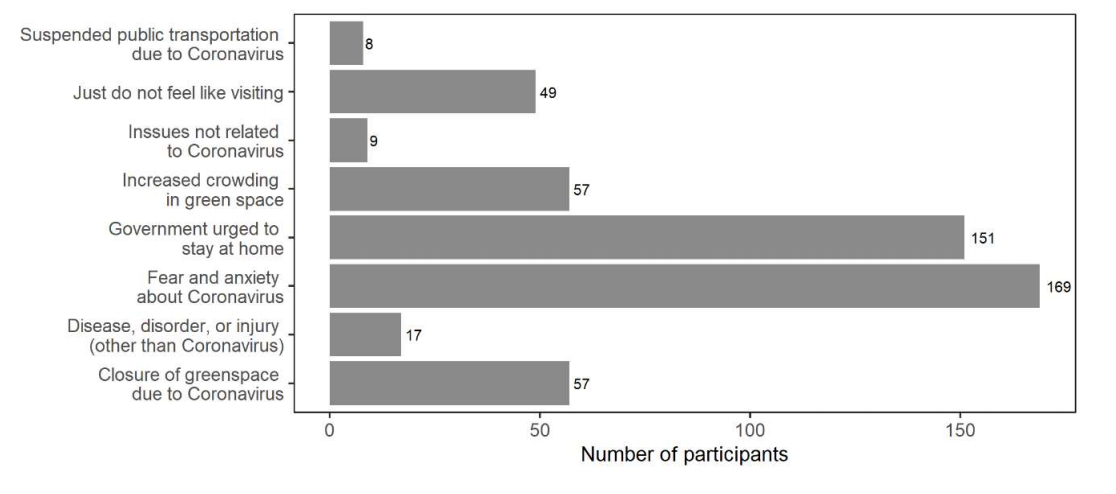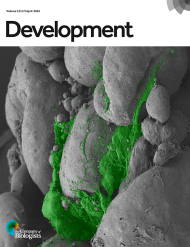Impact of Changed Use of Greenspace during COVID-19 Pandemic on Depression and Anxiety
Posted on: 21 June 2021
Preprint posted on 21 June 2021
Reduced access to greenspace during the Covid-19 pandemic linked to an increase in depression and anxiety
Selected by Thomas NeilCategories: epidemiology, immunology, physiology
Overview
The COVID-19 pandemic has affected the way people go about their lives in numerous different ways. The sudden shift from normality to lives behind close doors came swiftly, with everyone having to quickly adjust their daily routines to mitigate the spread of the novel SARS-CoV-2 virus.
Whilst these lockdowns have proven to be effective in stopping the virus spreading amongst a population, going into lockdown does come with its own detrimental caveats which can not be ignored. The impact of lockdowns on mental health is a critical factor in understanding the effect of COVID-19 on a population and is something which went somewhat unnoticed in the early parts of 2020. Whilst going into isolation may stave of the threat of contracting coronavirus, the effects of being forced to stay inside may be just as devastating to some people.
This has since become a hot topic of research, with studies looking into how different impacts of lockdowns have affected people’s mental wellbeing over the past year. Now, a study by researchers at Yale University has investigated changes in the use of greenspace during the pandemic, and the possible impacts of these changes on the mental health of those people who may not be able to visit such spaces as often as they did before.
Access to greenspaces is important, with growing evidence suggesting that visits to greenspaces can promote wellbeing through psychological and physical health benefits. These improvements can be brought about by factors such as stress relief, physical activity, and social cohesion. The onset of the COVID-19 pandemic has altered the accessibility of greenspaces, with the authors of this study identifying 4 potential pathways for altered greenspace use during the past year. These are summarised in Figure 1 as:
- A decreased use of greenspace due to lockdown
- Fear of contracting coronavirus leading to less visits to public spaces
- Those with existing mental health issues being even less likely to initiate a restorative visit
- The use of greenspaces actually increasing in those individuals who find themselves with more time on their hands than they had pre-pandemic.

Figure 1. Pathways of changes in interactions with greenspace during the pandemic and their effects on mental health.
To investigate how the use of greenspaces has changed during the pandemic, and the associated impact on mental health, the authors constructed a series of online questionnaires that were completed by participants in South Korea.
Results
The survey was completed by 209 participants. Of those, 65% of people said their visits to greenspaces had decreased from the year prior to the pandemic (2019) to the year of the pandemic (2020). 15% of participants said the frequency of visits had not changed, whilst 20% said that it had increased.
The most common reason given for a decrease in frequency of visits to greenspaces was fear and anxiety about coronavirus, with 81% of participants citing it as a reason for fewer visits. This was followed by the reasons of a government-enforced stay-at-home order (72%), whilst 30% of participants said their decrease in visits was a result of overcrowding at the greenspaces available to them (Figure 2).

Figure 2. Factors influencing decisions to visit greenspace in 2020 for those participants who have decreased their number of visits during the pandemic.
The study also looked to ask participants their reasons for visiting greenspaces prior to and during the pandemic. Compared to 2019, fewer respondents reported visiting greenspace for relaxation, spending time with friends or family and exercise. Those that did visit greenspace also reported an increase in general hygiene awareness, with 70% of the study participants washing their hands frequently, and 84% avoiding large groups and gatherings, whilst 90% wore a face mask.
Analysis into how an individual’s income might affect their visits to greenspace revealed that it is those on a medium level of income that saw their visits decrease the most, when compared to those with higher and lower incomes.
Amongst the participants, the prevalence of probable major depression was 19% and the prevalence of probable generalized anxiety disorder was 15%. An analysis into the association between visits to greenspace and risk of major depression revealed that those that said they had decreased their visits to greenspaces during the pandemic were two times more likely to experience probable major depression than those that either maintained or increased their frequency of visits. They found no link between changes in visit frequency and probable generalized anxiety disorder.
What I like about this preprint
This preprint gives a valuable insight into some of the issues that may not have initially been considered at the start of the pandemic but are becoming increasingly more important as we learn more about the wider implications and the effects of lockdown on people’s mental wellbeing. The authors use a robust method of questionnaires to gain a large amount of data on how people’s behaviour has changed during the past year, with the results having far reaching implications.
Future implications
The use and access to greenspaces was already an important issue prior to the pandemic, with evidence indicating that those living in cities suffer from not having readily available access to outdoor space. This study further highlights these issues and brings the importance of this access to the forefront of public health awareness, with this study demonstrating that barriers to greenspaces affect people’s mental wellbeing. This is particularly important among lower-income communities, where people already face relatively worse health status, limited access to health care and living in more polluted areas. The results here highlight the importance of removing barriers to greenspace, as well as the need for identifying high-risk groups from mental health outcomes and for developing better psychological interventions.
Questions to authors
What do you think could be done to better cater for people who suffer from the detrimental affects of changes in greenspace use during the pandemic?
How might you try to unpick the data to better understand whether the identified increase in risk of major depression and generalised anxiety disorder were directly a consequence of not being able to visit green spaces, vs the possibility that not visiting green spaces came about due to already displaying major depression and generalised anxiety disorder symptoms. Would this require a follow-up study?
doi: https://doi.org/10.1242/prelights.29669
Read preprintSign up to customise the site to your preferences and to receive alerts
Register hereAlso in the epidemiology category:
Green synthesized silver nanoparticles from Moringa: Potential for preventative treatment of SARS-CoV-2 contaminated water
Safieh Shah, Benjamin Dominik Maier
Multimodal interactions in Stomoxys navigation reveals synergy between olfaction and vision
Maitri Manjunath
Mapping current and future thermal limits to suitability for malaria transmission by the invasive mosquito Anopheles stephensi
Sophia Friesen
Also in the immunology category:
Discovery of a Potent and Selective Inhibitor of Human NLRP3 with a Novel Binding Modality and Mechanism of Action
Roberto Amadio
IMMClock reveals immune aging and T cell function at single-cell resolution
Jessica Chevallier
Target cell tension regulates macrophage trogocytosis
Felipe Del Valle Batalla
Also in the physiology category:
Hyaluronic Acid and Emergent Tissue Mechanics Orchestrate Digit Tip Regeneration
Jonathan Townson
Scaly-Tail Organ Enhances Static Stability during Pel’s Scaly-tailed Flying Squirrels’ Arboreal Locomotion
EMB EMB_Liv et al.
Megakaryocytes assemble a three-dimensional cage of extracellular matrix that controls their maturation and anchoring to the vascular niche
Simon Cleary
preLists in the epidemiology category:
BioMalPar XVI: Biology and Pathology of the Malaria Parasite
[under construction] Preprints presented at the (fully virtual) EMBL BioMalPar XVI, 17-18 May 2020 #emblmalaria
| List by | Dey Lab, Samantha Seah |
1
COVID-19 / SARS-CoV-2 preprints
List of important preprints dealing with the ongoing coronavirus outbreak. See http://covidpreprints.com for additional resources and timeline, and https://connect.biorxiv.org/relate/content/181 for full list of bioRxiv and medRxiv preprints on this topic
| List by | Dey Lab, Zhang-He Goh |
1
Antimicrobials: Discovery, clinical use, and development of resistance
Preprints that describe the discovery of new antimicrobials and any improvements made regarding their clinical use. Includes preprints that detail the factors affecting antimicrobial selection and the development of antimicrobial resistance.
| List by | Zhang-He Goh |
Also in the immunology category:
Community-driven preList – Immunology
In this community-driven preList, a group of preLighters, with expertise in different areas of immunology have worked together to create this preprint reading list.
| List by | Felipe Del Valle Batalla et al. |
Journal of Cell Science meeting ‘Imaging Cell Dynamics’
This preList highlights the preprints discussed at the JCS meeting 'Imaging Cell Dynamics'. The meeting was held from 14 - 17 May 2023 in Lisbon, Portugal and was organised by Erika Holzbaur, Jennifer Lippincott-Schwartz, Rob Parton and Michael Way.
| List by | Helen Zenner |
Fibroblasts
The advances in fibroblast biology preList explores the recent discoveries and preprints of the fibroblast world. Get ready to immerse yourself with this list created for fibroblasts aficionados and lovers, and beyond. Here, my goal is to include preprints of fibroblast biology, heterogeneity, fate, extracellular matrix, behavior, topography, single-cell atlases, spatial transcriptomics, and their matrix!
| List by | Osvaldo Contreras |
Single Cell Biology 2020
A list of preprints mentioned at the Wellcome Genome Campus Single Cell Biology 2020 meeting.
| List by | Alex Eve |
Autophagy
Preprints on autophagy and lysosomal degradation and its role in neurodegeneration and disease. Includes molecular mechanisms, upstream signalling and regulation as well as studies on pharmaceutical interventions to upregulate the process.
| List by | Sandra Malmgren Hill |
Zebrafish immunology
A compilation of cutting-edge research that uses the zebrafish as a model system to elucidate novel immunological mechanisms in health and disease.
| List by | Shikha Nayar |
Also in the physiology category:
Biologists @ 100 conference preList
This preList aims to capture all preprints being discussed at the Biologists @100 conference in Liverpool, UK, either as part of the poster sessions or the (flash/short/full-length) talks.
| List by | Jonathan Townson, Jonathan Townson |
Fibroblasts
The advances in fibroblast biology preList explores the recent discoveries and preprints of the fibroblast world. Get ready to immerse yourself with this list created for fibroblasts aficionados and lovers, and beyond. Here, my goal is to include preprints of fibroblast biology, heterogeneity, fate, extracellular matrix, behavior, topography, single-cell atlases, spatial transcriptomics, and their matrix!
| List by | Osvaldo Contreras |
FENS 2020
A collection of preprints presented during the virtual meeting of the Federation of European Neuroscience Societies (FENS) in 2020
| List by | Ana Dorrego-Rivas |
TAGC 2020
Preprints recently presented at the virtual Allied Genetics Conference, April 22-26, 2020. #TAGC20
| List by | Maiko Kitaoka et al. |
Autophagy
Preprints on autophagy and lysosomal degradation and its role in neurodegeneration and disease. Includes molecular mechanisms, upstream signalling and regulation as well as studies on pharmaceutical interventions to upregulate the process.
| List by | Sandra Malmgren Hill |
Cellular metabolism
A curated list of preprints related to cellular metabolism at Biorxiv by Pablo Ranea Robles from the Prelights community. Special interest on lipid metabolism, peroxisomes and mitochondria.
| List by | Pablo Ranea Robles |











 (No Ratings Yet)
(No Ratings Yet)